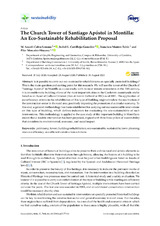The Church Tower of Santiago Apóstol in Montilla: An Eco-Sustainable Rehabilitation Proposal
Autor
Calvo-Serrano, M. Araceli
Castillejo-González, I.L.
Montes Tubío, Francisco de Paula
Mercader-Moyano, Pilar
Editor
MDPIFecha
2020Materia
PatrimonyTower
Buildings rehabilitation
Eco-sustainable
Sustainable
Town planning
Resource efficiency
Eco-efficient construction solutions
METS:
Mostrar el registro METSPREMIS:
Mostrar el registro PREMISMetadatos
Mostrar el registro completo del ítemResumen
Is it possible to carry out eco-sustainable rehabilitations on specially protected buildings? This is the main question and starting point for this research. We will use the tower of the Church of “Santiago Apóstol” in Montilla as a case study; with its most remote antecedents in the 15th century, it is an emblematic building of one of the most important cities in the Cordovan countryside and is listed as an Asset of Cultural Interest (Bien de Interés Cultural or BIC) as of 2001. The application of eco-efficiency criteria in the rehabilitation of this type of building might stimulate the reactivation of the construction sector in the rural area, positively impacting the promotion of a circular economy. To this end, a general methodology has been established for carrying out eco-sustainable renovations on this type of building, which defines indicators for evaluating the eco-sustainability of such interventions. This methodology is applied to the case study of this important building in Montilla to ensure that a feasible intervention has been proposed, aligned with three basic pillars of sustainability that considers its environmental, economic, and social impact.

